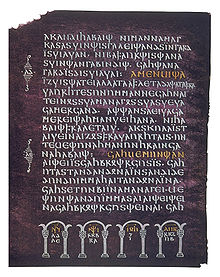

Purple parchment or purple vellum refers to parchment dyed purple; codex purpureus refers to manuscripts written entirely or mostly on such parchment. The lettering may be in gold or silver. Later[when?] the practice was revived for some especially grand illuminated manuscripts produced for the emperors in Carolingian art and Ottonian art, in Anglo-Saxon England and elsewhere. Some just use purple parchment for sections of the work; the 8th-century Anglo-Saxon Stockholm Codex Aureus alternates dyed and un-dyed pages.
It was at one point supposedly restricted for the use of Roman or Byzantine emperors, although in a letter of Saint Jerome of 384, he "writes scornfully of the wealthy Christian women whose books are written in gold on purple vellum, and clothed with gems".[1]
- ^ Needham, 21